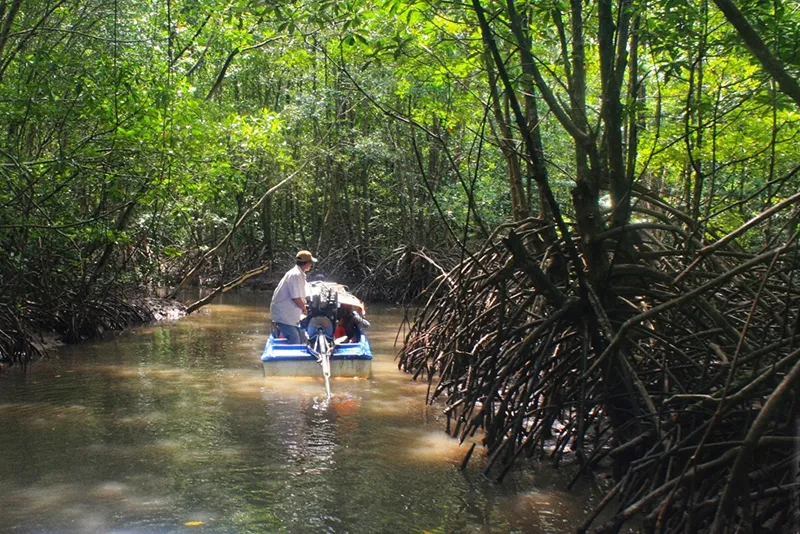When visiting Ca Mau, the sacred southernmost point of Vietnam, tourists not only admire the sovereignty milestone but also have the opportunity to immerse themselves in the pristine and majestic nature of the mangrove forest in Mui Ca Mau National Park. This place is known as one of the largest mangrove forests in the world, containing a diverse and unique ecosystem, promising unforgettable experiences.
Mui Ca Mau National Park: Vietnam’s Miniature “Amazon”
Covering an area of over 63,000 hectares, the Ca Mau mangrove forest proudly ranks second in the world in terms of scale, only after the legendary Amazon rainforest. The vastness and importance of this forest have earned it the nickname “green lung” of the region, playing a key role in regulating the climate and protecting the environment.

The Ca Mau mangrove forest is not just a simple forest but also a complex ecosystem, home to countless rare and precious flora and fauna.
Diverse Ecosystem of Ca Mau Mangrove Forest
The rich vegetation of the Ca Mau mangrove forest includes 22 species of trees capable of tolerating alum and salinity, such as cajeput, mangrove apple, stilt-root mangrove, cork tree, and wild date palm. However, the most prominent and largest in area is still the mangrove tree (đước). Therefore, the Ca Mau mangrove forest is also known as the Duoc Ca Mau forest, or Sac forest in the familiar language of the locals.

The mangrove tree (Rhizophora apiculata Blume) is a woody plant, growing straight, round with a diameter of 30-45cm, gray-brown bark, and an average height of 20-35m. Mangroves usually grow in coastal areas, salt-marsh plains, with tropical and subtropical climates. In particular, mangrove trees thrive best on fine mud soil, in brackish and saltwater areas near river mouths and estuaries, where tides rise and fall regularly. The hot and humid climate of Vietnam, especially the Ca Mau Cape region, is an ideal environment for mangrove trees to grow and develop.
Unique Biological Characteristics of Mangrove Trees
Living in a harsh alum-saltwater environment, mangrove trees have evolved a special root system to adapt. The root system of mangrove trees has a rather massive structure compared to the trunk, divided into two main parts: taproots and prop roots. Taproots are small, plunging straight into the mud to anchor the tree. Prop roots develop in clusters, growing from the trunk near the base and clinging tightly to the surrounding soil, helping the tree stand firm against storms and currents. In addition to the function of support, prop roots also have the task of absorbing water and nutrients from the soil.

Once mangroves have grown into a forest, no other type of tree can intervene. Mangroves act as a “bodyguard” protecting the coast, helping to protect and restore coastal forests in Ca Mau, preventing saltwater intrusion and shielding against storms. Each year, mangrove forests and mangrove forests, along with alluvial deposits, encroach upon the sea by 50-80m for the country.
Great Economic and Ecological Value of Mangrove Forests
Mangrove forests are not only the “home” of many aquatic species of high economic value such as crabs, shrimp, clams, three-striped crabs, mudskippers, but also provide important raw materials for life and production. Mangrove wood is used to make tables, chairs, beds, cabinets, build houses, floors, and monkey bridges. Mangrove charcoal has high heat, and is a valuable export commodity. Mangrove bark is also used for tanning leather, dyeing fabrics, printing, etc.

Today, the Ca Mau mangrove forest stretches across six districts: Dam Doi, Phu Tan, Tran Van Thoi, U Minh, Ngoc Hien, and Nam Can, mainly concentrated in the two districts near the southernmost point, Nam Can and Ngoc Hien. Most of the mangrove forest area belongs to the “Mui Ca Mau World Biosphere Reserve”. Mui Ca Mau National Park alone has an area of up to 15,000ha.
Attractive Ecotourism Routes in Ca Mau Mangrove Forest
Since the Nam Can bridge was inaugurated in 2016, traveling to Ca Mau Cape has become easier than ever, both by waterway and by road. On the way, visitors can admire the pristine mangrove forest ecosystem stretching from Nam Can town to the southernmost point of the country.

However, the most interesting and Western-style experience is still by waterway, from Nam Can wharf, taking a canoe or speedboat on the Cua Lon River, weaving through the green mangrove forests out to sea, to Ca Mau Cape.
In recent years, Mui Ca Mau National Park has invested in building a system of road bridges, creating favorable conditions for visitors to walk and explore the pristine mangrove forest landscape.

Ca Mau mangrove forest is an ideal destination for scientific researchers and has the greatest ecotourism potential in the Mekong Delta. Currently, Mui Ca Mau National Park has put into operation four ecotourism routes:
- Route 1: Visiting mangrove forests and alluvial grounds.
- Route 2: Exploring the “sky well” (giếng trời) and pristine forest.
- Route 3: Visiting natural forest performances and Ông Trang sandbar.
- Route 4: Visiting the alluvial grounds along the East Sea, mangrove forests, and alluvial grounds along the West Sea.

Explore Ca Mau Primitive Forest: An Unmissable Journey
The Ca Mau primitive forest tour is a great opportunity for visitors to explore the unspoiled and majestic beauty of nature, learn about the unique ecosystem of the mangrove forest, and experience exciting activities. Come to Ca Mau and discover the “green lung” of the world for yourself!